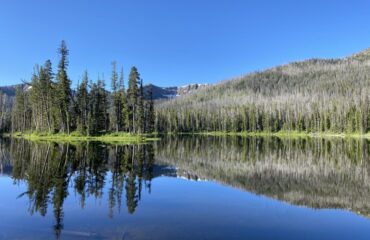Overland FAQ
Here are a couple questions and answers frequently asked by new overlander’s. Hope these answers help to get you on your way to adventure.
What is the Overland Lifestyle?
The overland lifestyle is a way of life that centers around exploration and adventure. It’s about traveling off the beaten path, exploring remote and beautiful locations, and experiencing new cultures and environments. Overlanding involves traveling by vehicle, typically a 4×4, with the goal of self-sufficiently exploring the outdoors, often for extended periods of time.
The overland lifestyle is not just about the act of traveling itself but also about the mindset and values that go along with it. It’s about seeking new experiences, being self-reliant, and respecting and preserving the natural environment. Many overlanders have a deep appreciation for nature and the outdoors and strive to minimize their impact on the environment while traveling.
Overlanders often equip their vehicles with specialized gear and equipment to make the journey more comfortable and self-sufficient. This can include items such as rooftop tents, portable showers, solar panels, and water filtration systems. Overlanding also often involves camping and cooking outdoors, which adds to the sense of adventure and self-sufficiency.
The overland lifestyle can appeal to a wide range of people, from those seeking a break from the hustle and bustle of modern life to those who crave adventure and exploration. It’s a lifestyle that encourages self-discovery, personal growth, and a sense of community with like-minded individuals. Many overlanders find that the experience of traveling off the beaten path and connecting with nature is a transformative one, leading to a deeper appreciation for the world around them.
Do you need 4×4 to Overland?
While a 4×4 vehicle is often preferred for overlanding, it’s not always necessary. It ultimately depends on the terrain you plan to tackle and your comfort level.
If you plan to stick to well-maintained roads and avoid challenging terrain, a 4×2 vehicle may be sufficient. However, if you plan to tackle rough terrain, steep inclines, or off-road trails, a 4×4 vehicle will provide better traction and stability.
That being said, a 4×4 vehicle can be a significant investment, and it’s not always necessary for every overlanding trip. It’s important to evaluate your specific needs and budget before making a decision on whether or not to invest in a 4×4 vehicle.
Regardless of whether you choose a 4×2 or 4×4 vehicle, it’s important to prioritize safety and preparation. Make sure your vehicle is well-maintained and equipped with essential safety features like proper tires, recovery gear, and a first-aid kit.
Additionally, it’s important to research your destination and the terrain you plan to tackle. Familiarize yourself with the area’s weather conditions, potential hazards, and any permits or regulations that may be required. By doing your research and prioritizing safety, you can have a successful and enjoyable overlanding trip regardless of whether or not you have a 4×4 vehicle.
Where do you sleep when overlanding?
When overlanding, there are several options for sleeping depending on your preferences and the resources available. Here are a few common options:
- Rooftop Tents: Rooftop tents are a popular option for overlanders as they provide a comfortable and elevated sleeping space. They can be easily set up and taken down, and they keep you off the ground away from potential critters.
- Ground Tents: Ground tents are also a popular choice for overlanders. They come in a variety of sizes and styles and can be set up on the ground or on a platform. Ground tents provide more interior space and often have vestibules for additional storage.
- Sleeping in Your Vehicle: Depending on the size of your vehicle, you may be able to set up a sleeping area inside. This can be a cost-effective option and provides additional protection from the elements.
- Hammocks: Hammocks are a lightweight and portable option for overlanders. They can be set up between trees or on a hammock stand, and they’re a great option for warmer weather.
- Cabins or Camping Pods: Some overlanding destinations may offer cabins or camping pods for rent. These provide a more comfortable and secure sleeping space and often come equipped with amenities like electricity and heating.
Camper trailers are also a popular option for overlanders, especially for those who prefer a more permanent and comfortable sleeping space.
Camper trailers come in a variety of sizes and styles, from small teardrop trailers to larger models with multiple sleeping areas, kitchens, and bathrooms. They provide a comfortable and secure sleeping space with amenities like air conditioning, heating, and electricity.
Camper trailers also offer the advantage of being able to unhitch and leave at a campsite while exploring the surrounding areas in your vehicle. This can be especially convenient for longer trips or for families with young children who may require a more stable and spacious sleeping area.
Of course, camper trailers do come with some drawbacks. They can be more expensive than other sleeping options, and they require a larger vehicle with the appropriate towing capacity. Additionally, they may be restricted in certain off-road areas that have size or weight restrictions.
Ultimately, the choice of where to sleep while overlanding depends on your preferences and the resources available. It’s important to prioritize safety and comfort when choosing a sleeping option and to be prepared for any potential weather or wildlife hazards.
What is the difference between overlanding and camping?
While overlanding and camping share some similarities, there are some distinct differences between the two activities.
Camping typically involves setting up a campsite in a designated camping area or campground, often with established campsites, fire pits, and other amenities. Camping is generally a recreational activity that focuses on enjoying nature, relaxing, and spending time outdoors.
Overlanding, on the other hand, is a more adventurous activity that involves traveling off the beaten path to explore remote areas and experience the journey as much as the destination. Overlanding often involves traveling over longer distances, with the goal of reaching a specific destination or exploring a particular route or area.
Overlanding requires a higher level of self-sufficiency than camping, as overlanders often need to bring their own food, water, and other supplies, and they may need to be prepared for mechanical issues or unexpected situations while on the road. Overlanders also often use specialized vehicles, like 4×4 trucks or SUVs, to navigate rough terrain and reach remote areas.
While camping and overlanding can both be rewarding outdoor experiences, the main difference lies in the level of adventure and self-sufficiency required. Camping is often a more relaxed and leisurely activity, while overlanding requires more preparation, planning, and a spirit of adventure.
How should I dress for Overlanding?
When it comes to dressing for overlanding, it’s important to consider a few key factors to ensure your comfort, safety, and preparedness for any weather or conditions you may encounter on the road. Here are some tips for dressing for overlanding:
- Layer up: Depending on the climate and time of year, temperatures can vary widely during an overlanding trip. Dress in layers so you can easily adjust your clothing to match the temperature and weather conditions.
- Choose moisture-wicking materials: Sweat and moisture can make you feel uncomfortable and lead to chafing, especially during long hours on the road. Look for clothing made from moisture-wicking materials, such as polyester or merino wool, that will keep you dry and comfortable.
- Opt for durable and functional clothing: Overlanding can be tough on clothing, so choose items that are durable and functional. Look for clothing with reinforced seams, ripstop fabric, and pockets for storage.
- Wear comfortable and sturdy footwear: Your footwear should be comfortable and sturdy enough to handle hiking, off-road driving, and any other activities you have planned. Choose boots or shoes with good traction, ankle support, and a waterproof or water-resistant membrane.
- Protect yourself from the sun: Overlanding often involves spending long hours in the sun, so it’s important to protect yourself from harmful UV rays. Wear a hat with a wide brim to shade your face and neck, and apply sunscreen regularly.
- Pack for the conditions: Be sure to pack clothing and gear appropriate for the conditions you may encounter on your trip. If you’ll be traveling in colder weather, bring warm layers and a hat and gloves. If you’ll be in a rainy climate, pack a waterproof jacket and pants.
By following these tips and packing the right clothing and gear, you can stay comfortable, safe, and prepared for any conditions you may encounter while overlanding.
Why are Toyotas so popular for overlanding?
Toyota vehicles are popular for overlanding for several reasons, including:
- Durability and reliability: Toyota has a reputation for building vehicles that are incredibly durable and reliable, which is essential for overlanding where you need a vehicle that can handle rough terrain and remote locations. Toyota’s build quality and reliability have made them a go-to choice for overlanders who need a vehicle that they can trust to get them to their destination.
- Off-road capability: Many Toyota vehicles, like the 4Runner and Land Cruiser, have a reputation for being highly capable off-road vehicles. They come equipped with features like four-wheel drive, locking differentials, and high ground clearance, which make them ideal for navigating rocky terrain, steep inclines, and other challenging off-road conditions.
- Aftermarket support: The Toyota overlanding community is vast, and there is a huge market for aftermarket parts and accessories that can help owners customize their vehicles for off-road use. From suspension upgrades to roof racks, there is a wide range of products available to help owners get the most out of their Toyota overlanding rig.
- Resale value: Toyota vehicles have a reputation for holding their value well, which is important for overlanders who invest a lot of money into their rigs. When it’s time to sell or upgrade their vehicle, Toyota owners can typically recoup more of their investment than owners of other brands.
Overall, Toyota vehicles offer a combination of durability, reliability, off-road capability, and aftermarket support that make them an excellent choice for overlanding. The popularity of Toyota for overlanding has also created a strong community of owners and enthusiasts who share tips, resources, and support for each other both on and off the road.





